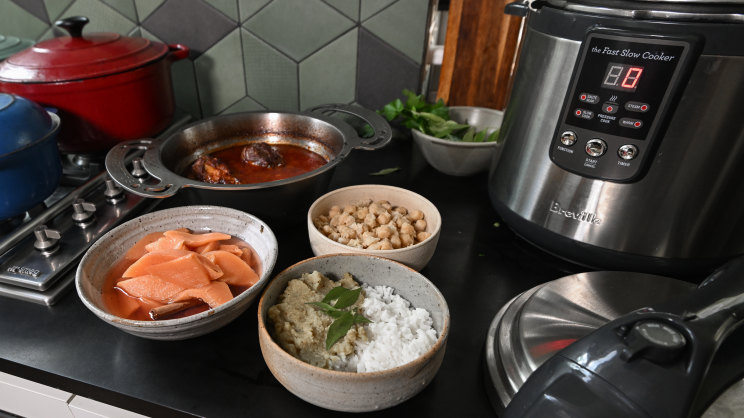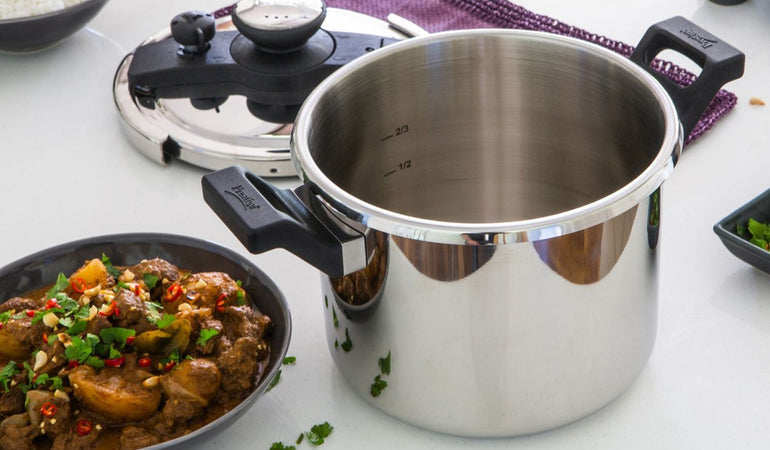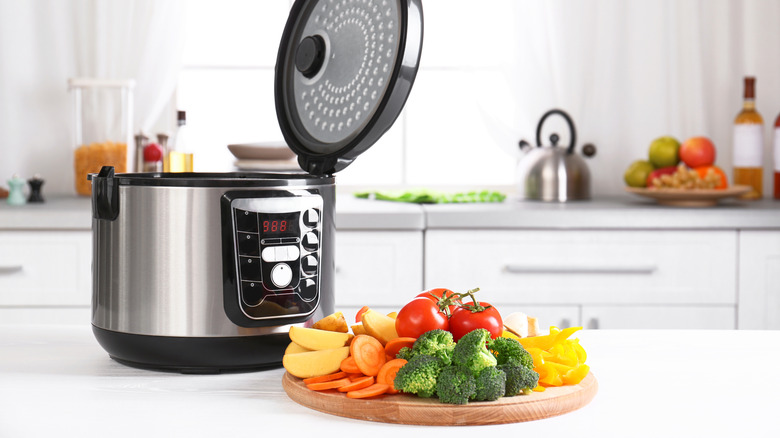How to Cook Beets in a Pressure Cooker: A Comprehensive Guide for Flavorful Results
Written By James Morgan
Beets are an incredibly versatile and nutrient-rich vegetable that can be prepared in numerous ways. One of the most efficient and flavorful methods of cooking beets is by using a pressure cooker. In this all-encompassing guide, we will delve deeply into the steps, techniques, and tips on how to cook beets in a pressure cooker to ensure delectable results every time.

Why Cook Beets in a Pressure Cooker?
Beets are known for their earthy flavor, vibrant color, and abundant health benefits, including high levels of vitamins, minerals, and antioxidants. Cooking beets in a pressure cooker significantly reduces cooking time while preserving their nutrients and enhancing their natural sweetness. Unlike traditional boiling or roasting methods, pressure cooking beets ensures they remain tender, succulent, and easy to peel. Additionally, using a pressure cooker is highly convenient for busy home cooks, offering a hands-off approach to meal preparation. For another healthy recipe, check out our tuna casserole.

Choosing the Right Beets
To achieve the best results, it's important to start with high-quality, fresh beets. When selecting beets, look for those that are firm, smooth-skinned, and free from blemishes or soft spots. The greens, if still attached, should be vibrant and fresh-looking, which is a good indicator of the beet's overall freshness. Beets come in several varieties, including red, golden, and striped (Chioggia), each with its own unique flavor profile. Feel free to mix and match different types based on your personal preference and the dish you're preparing.

Preparing Beets for Pressure Cooking
Before cooking beets in a pressure cooker, proper preparation is essential to ensure the best taste and texture. Follow these steps to get your beets ready for pressure cooking:
- Washing: Rinse the beets thoroughly under cold running water to remove any dirt and debris.
- Trimming: Using a sharp knife and an appropriate cutting board, trim the beet greens and root ends.
- Peeling: Depending on your preference, you can choose to peel the beets before or after cooking. Leaving the skins on can help retain more nutrients and is less messy, as the skins will easily slip off after pressure cooking.

Ingredients and Equipment
Ingredients
- 4-6 medium-sized beets
- 1 cup of water or vegetable broth
- Optional: Salt and pepper to taste, fresh herbs, balsamic vinegar, or olive oil
Equipment
- A pressure cooker
- Knife
- Cutting board
- Optional: Steamer basket or trivet
Step-by-Step Guide on How to Cook Beets in a Pressure Cooker
Step 1: Adding Liquid
Begin by adding 1 cup of water or vegetable broth to the pressure cooker. The liquid is essential for generating the steam needed to cook the beets and to prevent them from drying out during the cooking process. If you prefer a more flavorful result, using vegetable broth can add an extra layer of taste to the beets.
Step 2: Arranging the Beets
Place the prepared beets in the pressure cooker. If you have a steamer basket or trivet, you can use it to elevate the beets slightly above the liquid, ensuring even cooking. If you're placing the beets directly in the liquid, make sure they're arranged in a single layer to promote uniform cooking.
Step 3: Sealing the Pressure Cooker
Secure the lid of the pressure cooker and set the valve to the sealing position. This step is crucial for building pressure inside the cooker, which is necessary for the rapid cooking process. Ensure that the pressure cooker is properly sealed to avoid any steam leakage.
Step 4: Setting the Cooking Time
Set the pressure cooker to high pressure and adjust the cooking time based on the size of the beets. Generally, medium-sized beets (approximately 2 inches in diameter) require around 15-20 minutes of cooking time. Larger beets may need up to 25 minutes, while smaller beets can cook in as little as 10-12 minutes. It's always best to consult your pressure cooker's manual for specific settings and guidelines.
Releasing the Pressure
Natural Pressure Release
Once the cooking time is complete, allow the pressure to release naturally for about 10-15 minutes. This gradual release helps to prevent the beets from becoming overly soft or mushy. After the natural release period, carefully turn the valve to the venting position to release any remaining pressure.
Quick Pressure Release
If you're in a hurry, you can opt for a quick pressure release by immediately turning the valve to the venting position once the cooking time is complete. However, be cautious, as this method can cause the beets to become softer than desired. Use the quick pressure release with care, and avoid placing your hand directly over the steam vent to prevent burns.
Testing for Doneness
To ensure the beets are perfectly cooked, use a fork or knife to check for tenderness. The beets should be easily pierced without much resistance. If the beets are not as tender as desired, you can reseal the pressure cooker and cook for an additional 2-3 minutes, followed by another natural or quick release. It's important to avoid overcooking the beets, as they can become overly soft and lose their texture.
Peeling and Serving
Once the beets are cooked to perfection, allow them to cool slightly before handling. The skins should easily slip off when gently rubbed with your fingers or a paper towel. Peeling the beets after cooking can help retain their vibrant color and nutrients. You can serve the beets whole, sliced, or diced, depending on your preference and the recipe you're preparing.
Serving Suggestions
Cooked beets can be enjoyed in various ways, making them a versatile addition to any meal. Here are some serving suggestions to inspire you:
- Beet Salad: Toss cooked and sliced beets with mixed greens, goat cheese, walnuts, and a balsamic vinaigrette for a refreshing and nutritious salad.
- Roasted Beet Soup: Blend cooked beets with vegetable broth, garlic, and a touch of cream to create a comforting and vibrant beet soup.
- Roasted Vegetable Medley: Combine cooked beets with roasted carrots, potatoes, and onions for a hearty and colorful vegetable medley.
- Beet Hummus: Puree cooked beets with chickpeas, tahini, garlic, and lemon juice for a unique and vibrant beet hummus.
Tips and Tricks for Perfectly Cooked Beets
- Uniform Size: Try to select beets of similar size to ensure even cooking. If the beets vary in size, you can cut larger beets into smaller pieces to match the size of the smaller beets.
- Flavor Enhancements: Experiment with different herbs, spices, and seasonings to enhance the flavor of the cooked beets. Fresh herbs like dill, thyme, and parsley pair exceptionally well with beets.
- Storage: If you have leftover cooked beets, store them in an airtight container in the refrigerator for up to one week. Cooked beets can also be frozen for longer storage, although their texture may change slightly upon thawing.
- Avoid Overcrowding: When using a pressure cooker, avoid overcrowding the beets, as this can lead to uneven cooking. Cook in batches if necessary to ensure consistent results.
- Acidic Additions: To prevent beets from losing their color during cooking, you can add a splash of balsamic vinegar or lemon juice to the cooking liquid. This helps to maintain their vibrant hue.
Cleaning and Maintenance
After enjoying your delicious beets, it's important to clean your cookware properly to maintain its performance and longevity. Here are some recommended cleaning products:
As an Amazon Associate, I earn from qualifying purchases.
Final Thoughts
Learning how to cook beets in a pressure cooker opens up a world of culinary possibilities, allowing you to enjoy this nutritious and flavorful vegetable in various delicious ways. By following the steps and tips outlined in this guide, you'll be able to achieve perfectly cooked beets with minimal effort and maximum flavor. Whether you're preparing a quick weeknight dinner or experimenting with new recipes, pressure-cooked beets are sure to elevate your culinary creations. Dive into the wonderful world of beets and discover the incredible taste and health benefits they have to offer!
If you're looking for more ways to maximize your pressure cooker, consider learning rice cooking techniques. Also, explore vibrant and exciting recipes like the Avocado Bomb Sushi to elevate your cooking game. For a collection of pressure cooker recipes, visit Delish.



